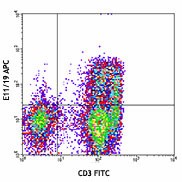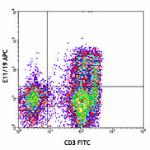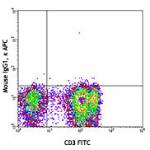- Clone
- E11/19 (See other available formats)
- Regulatory Status
- RUO
- Other Names
- CD195, CCR5, C-C chemokine receptor type 5, HIV-1 fusion co-receptor
- Isotype
- Mouse IgG1, κ
- Ave. Rating
- Submit a Review
- Product Citations
- publications

-

PMA (100 ng/ml)-stimulated (5 minutes) human peripheral blood lymphocytes surface stained with CD3 FITC and intracellularly stained with CD195 (clone E11/19) APC (top) or mouse IgG1, κ APC isotype control (bottom). -

| Cat # | Size | Price | Quantity Check Availability | Save | ||
|---|---|---|---|---|---|---|
| 321608 | 100 tests | 261€ | ||||
CD195, also known as CCR5, is a 45 kD G protein-coupled seven transmembrane CC-chemokine receptor. It binds to MIP-1α, MIP-1β, and RANTES and is expressed on a subset of T cells and monocytes. CD195 mediates an intracellular signal thought to induce cell differentiation and proliferation. CCR5 has also been shown to act as a co-receptor for R5 HIV-1 cell entry; modification of CCR5 by sulfation contributes to the efficiency of HIV-1 entry.
Product DetailsProduct Details
- Verified Reactivity
- Human
- Antibody Type
- Monoclonal
- Host Species
- Mouse
- Immunogen
- Phosphopeptide (CEAPERA(pS)(pS)VYTR(pS)TGEQI(pS)VGL) of CCR5
- Formulation
- Phosphate-buffered solution, pH 7.2, containing 0.09% sodium azide and BSA (origin USA)
- Preparation
- The antibody was purified by affinity chromatography and conjugated with APC under optimal conditions.
- Concentration
- Lot-specific (to obtain lot-specific concentration, please enter the lot number in our Concentration and Expiration Lookup or Certificate of Analysis online tools.)
- Storage & Handling
- The antibody solution should be stored undiluted between 2°C and 8°C, and protected from prolonged exposure to light. Do not freeze.
- Application
-
ICFC - Quality tested
- Recommended Usage
-
Each lot of this antibody is quality control tested by intracellular immunofluorescent staining with flow cytometric analysis. For flow cytometric staining, the suggested use of this reagent is 5 µl per million cells in 100 µl staining volume or 5 µl per 100 µl of whole blood.
- Excitation Laser
-
Red Laser (633 nm)
- Application Notes
-
The E11/19 monoclonal antibody binds to phosphoserine 349 corresponding to 22 c-terminal amino acid residues of human CCR5 and is useful for flow cytometric analysis, immunoblotting, and ELISA assay of CCR5 expression. Additional reported applications (for the relevant formats) include: immunofluorescence microscopy1, and ELISA detection1 when paired with T21/8 as the capture antibody (Cat. No. 321401/321402).
- Application References
- RRID
-
AB_10900994 (BioLegend Cat. No. 321608)
Antigen Details
- Structure
- G-coupled receptor family 1, membrane protein, 45 kD
- Distribution
-
Subset of T cells, monocytes
- Function
- Binds C-C chemokines and transduces an intracellular signal thought to result in proliferation and differentiation. Acts as a co-receptor with CD4 for HIV-1.
- Ligand/Receptor
- MIP-1a, MIP-1ß, RANTES
- Cell Type
- Monocytes, T cells
- Biology Area
- Immunology
- Molecular Family
- CD Molecules, Cytokine/Chemokine Receptors, GPCR, Phospho-Proteins
- Antigen References
-
1. Samson M, et al. 1996. Biochemistry 35:3362.
2. Raport CJ, et al. 1996. J. Biol. Chem. 271:17161.
3. Combadiere C, et al. 1996. J. Leukoc. Biol. 60:147.
4. Deng H, et al. 1996. Nature 381:661. - Gene ID
- 1234 View all products for this Gene ID
- UniProt
- View information about CD195 Phospho Ser349 on UniProt.org
Related Pages & Pathways
Pages
Related FAQs
- Does staining at room temperature or even at 37°C help for checking chemokine receptors expression?
-
Due to continuous recycling of many chemokine receptors, it may be worthwhile to consider staining at room temperature or at 37°C if the staining at lower temperature (which can potentially reduce receptor turnover) is not optimal.
Other Formats
View All CD195 Phospho (Ser349) Reagents Request Custom Conjugation| Description | Clone | Applications |
|---|---|---|
| PE anti-human CD195 (CCR5) Phospho (Ser349) | E11/19 | ICFC |
| APC anti-human CD195 (CCR5) Phospho (Ser349) | E11/19 | ICFC |
Compare Data Across All Formats
This data display is provided for general comparisons between formats.
Your actual data may vary due to variations in samples, target cells, instruments and their settings, staining conditions, and other factors.
If you need assistance with selecting the best format contact our expert technical support team.
-
PE anti-human CD195 (CCR5) Phospho (Ser349)

PMA (100ng/ml)-stimulated for 5 min (green histogram) and no... -
APC anti-human CD195 (CCR5) Phospho (Ser349)

PMA (100 ng/ml)-stimulated (5 minutes) human peripheral bloo... 
 Login / Register
Login / Register 













Follow Us